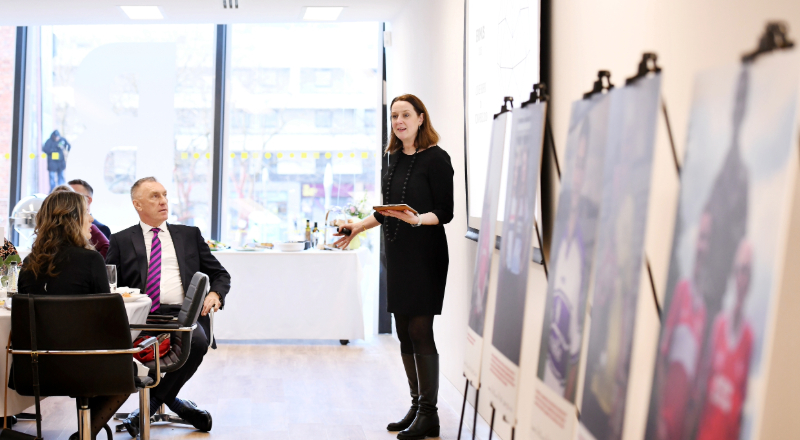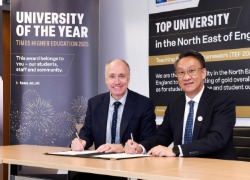Middlesbrough looks towards 2030 with vision to put culture at heart of town
An ambitious plan to put culture at the heart of Middlesbrough’s future has been announced as the town starts the countdown to its 200th anniversary.

Coinciding with the visit of King Charles and Queen Camilla, leading organisations in the town are setting out a bold vision of investment in culture and creativity between now and the bicentenary celebrations in 2030.
Thursday saw communities put on a vibrant welcome as the town hosted the United Kingdom’s Head of State for the first time since 1993. Middlesbrough Council, Teesside University, the Middlesbrough Institute of Modern Art (MIMA) and the Middlesbrough Cultural Partnership came together to host a huge public event in Centre Square.
Titled Love Boro, musical and poetry performances celebrated Centre Square’s designation as the cultural heart of the town.
More than 700 Middlesbrough schoolchildren who had attended a National Literary Trust at the town hall with Queen Camilla joined the crowds to wave off Their Majesties.
Dr Laura Sillars, Dean of Culture & Creativity at Teesside University, had earlier introduced the King and Queen to Stuart Langley, a Teesside artist whose public art installation Love IRL was on display in the square.
Dr Sillars said: 'A vibrant and hugely diverse cultural community sits at the heart of Middlesbrough. We are delighted to launch our ambitions to further nurture and grow this as we look towards 2030, the bicentenary of our town.
'Since its formation, Middlesbrough has been a place of innovation and creative spirit and the University and MIMA are proud to play such a key role in this.
'We have invited the King and Queen to return in 2030 as we celebrate our town’s next chapter.'
Councillor Philippa Storey, Deputy Mayor and Executive member for Culture and Education at Middlesbrough Council, said: 'Culture already plays a massive role in what’s attractive about our town. Our partners in the Middlesbrough Cultural Partnership have led the way for many years in bringing our communities together and hosting brilliant events and exhibitions.
'Having the 2030 anniversary to look forward to means we can place even more emphasis on culture and creativity and work together to come up with even more bold and imaginative ways to attract people to Middlesbrough.
'I’m confident the next five years can be brilliant for our town – particularly our young people – building on the inspirational work of the National Literacy Trust and others.'
Having the 2030 anniversary to look forward to means we can place even more emphasis on culture and creativity and work together to come up with even more bold and imaginative ways to attract people to Middlesbrough.
The past two years have seen over £80m invested in cultural infrastructure in the Middlesbrough, including the expansion of the MIMA Garden and the ongoing redevelopment of Central Library into a captivating literacy and learning space for children. Other recent developments include:
- Industry leading gaming firm Double Eleven choosing Boho X as its UK headquarters
- The launch of a refurbished Platform Arts Gallery and studio space in partnership with Network Rail
- The ongoing expansion of The Auxiliary, an artist-led studio and gallery complex for artist and creatives
- Middlesbrough Art Week winning best event or exhibition at the 2024 North East Culture Awards
- The upcoming opening of Teesside University’s Digital Life building
- The awarding of over £4m in National Lottery Heritage Fund backing for the redevelopment of the old Town Hall in St Hilda’s.
The significant cultural regeneration lays the foundation for Middlesbrough to attract a series of national projects, with ambitions for MIMA to host New Contemporaries and other major events over the next five years.
Other highlights on the horizon include:
- The 300th anniversary of the birth of Captain James Cook in 2028
- Plans for the development of a brand new museum in Stewart Park.
As well as the bicentenary in 2030, the same year sees Teesside University’s centenary and the 40th anniversary of Middlesbrough Mela, the longest running Mela in the UK.
Middlesbrough was born as the first railway town in the world in 1830, following the expansion of the first modern passenger railway to the port.
Rapid industrialisation saw the population grow from around 24 people to over 90,000 in the first 100 years. Almost 200 years later, Middlesbrough is a university town rich in culture, entrepreneurialism and innovation.
The bicentenary will celebrate the cultural diversity, creative spirit and community connections central to the future of the town. Calls for partners and participation will follow as the project further develops towards 2030.
In the News
Plan to make culture central to town's future
Northern Echo, Print and Web, 15/02/2025
The Middlesbrough Cultural Partnership announcement coincided with the visit of King Charles and Queen Camilla to the town.
Middlesbrough looks towards 2030 with vision to put culture at heart of town
Cision News, Web, 14/02/2025
An ambitious plan to put culture at the heart of Middlesbrough’s future has been announced as the town starts the countdown to its 200th anniversary.
Middlesbrough's Cultural Renaissance: A Vision for 2030
Parsers VC, Web, 14/02/2025
Middlesbrough is on the brink of a cultural renaissance. As the town gears up for its 200th anniversary in 2030, a bold vision is emerging.
Middlesbrough vision to put culture at heart of town
Tees Business, Web, 14/02/2025
Leading organisations in the town are setting out a bold vision of investment in culture and creativity between now and the bicentenary celebrations in 2030.
 Groundbreaking project to unlock nuclear energy's role in
...
Groundbreaking project to unlock nuclear energy's role in
... Start the new year by expanding your knowledge
Start the new year by expanding your knowledge  Teesside University strengthens long-standing partnership
...
Teesside University strengthens long-standing partnership
...